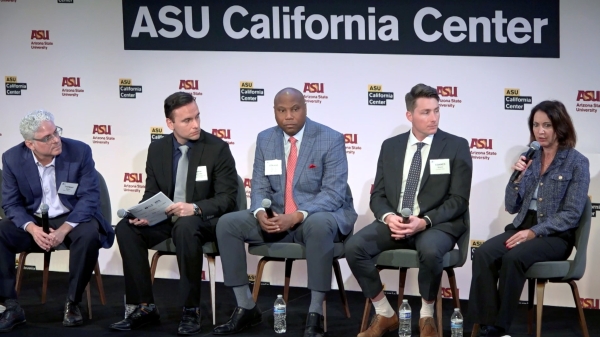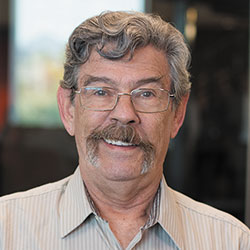The My Lai Massacre was one of the most shameful and atrocious chapters of the Vietnam War.
The March 16, 1968, slaughter of more than 500 unarmed civilians — men, women and children — by U.S. Army soldiers saw a quiet village set ablaze, women raped and mutilated and parents killed in front of their kids.
The savage event was covered up by the U.S. military and government brass for more than a year. When it was finally brought to light by American media, it outraged the world and exacerbated the growing anti-war sentiment in the United States.
A traveling exhibit chronicling the tragedy will come to Arizona State University Oct. 2-7 at ASU Downtown Phoenix Library at 411 N. Central Ave. Hosted by ASU’s Center on the Future of War and the Office for Veteran and Military Academic Engagement, the exhibit’s intention is to create a safe space for dialogue to navigate a contested history, to pose questions about the human costs of war and to commit to peace and social justice at home and abroad.
The exhibit will include photos, video, panel information, lectures, discussions and remembrances from Phoenix veterans. Michael Casavantes, a lecturer with the Walter Cronkite School of Journalism and Mass Communication, also will present “War Journalism and Film and War” at 11 a.m. on Oct. 7.
ASU Now spoke to Casavantes about his upcoming presentation and the role of journalism in war.
Michael Casavantes
Question: It’s been said that Vietnam was the first conflict that brought war into the American living room. Given that statement, how did media and television shape the particular outcome?
Answer: Coverage of Vietnam has often been referred to as the “Living Room War” simply because it became news after 1964-65 when American involvement escalated so dramatically. The one thing to remember, however, is that unlike the instantaneous coverage of today, the footage being seen on television was likely 48 to 72 hours old. The reporter had to get the film back to a major base and then find a pilot willing to take to the film to someplace like Tokyo where it would then be sent to New York. Once there, the film would be processed and the story would be carefully edited — not to advance an agenda, but rather so some kid’s mother doesn’t see him wounded or worse. That process normally took another 24 hours, so the “news” was really not that new, but it was highly visible on a nightly basis.
Press access was generally available. Show up at an airstrip at 6 a.m. and you could catch a plane or chopper to wherever something was happening. This unfettered access was during the initial phases of the war: The government and the military were hoping to further public support for stopping communism in Southeast Asia. When the reports began to detail failures of strategy and tactics, the relationship between the media and the government began to become more adversarial. The military was caught in the middle. They had a duty to do — and they all did it well — but the way they were being told to do it was not working and no one seemed to care.
Q: How did Vietnam change the way the media covered the war and future conflicts?
A: What truly changed following Vietnam was how the media interacted with both the government and the military. That “love-hate” triangle has occasionally been cooperative, but generally throughout history, the relationship has been adversarial. Coverage of events and U.S. involvement in Vietnam ranged from almost none during the late 1950s and early 1960s, to “It’s a secret” in the early to mid-1960s to almost unlimited access to combat troops in the mid- to late 1960s to “Why won’t you report what we tell you to report?” from the late 1960s until the end of American involvement.
There are many in the military, and throughout society, who believe that media coverage of Vietnam, in effect, “lost” the war for the United States. Vietnam marked a clear change in the relationship between the military, the media and the government from the common cause during World War II to open enmity still seen today. The initial government position was to minimize U.S. involvement and stress that the conflict was a South Vietnamese affair. Coverage of Vietnam was small: a few of the major papers and the wire services. As these reporters began seeing increasing evidence of U.S. involvement in the actual fighting, they began to report that as well, and that began to spark more interest. The incident that probably brought Vietnam into American consciousness was a major battle in early January 1963 at a place named Ap Bac. It was a major defeat for Army of the Republic of Vietnam (ARVN) troops and the American military advisers speaking with reporters laid the blame squarely on the South Vietnamese. The battle also cost the lives of three Americans. Washington and Saigon portrayed it as a victory.
The official briefings in Saigon were known as the “5 o'clock follies” because the information nearly always contradicted firsthand accounts and was “spun” to put everything in the best possible light. During one of his many visits to the Cronkite School of Journalism and Mass Communications, Mr. Walter Cronkite related to students how he had been present at an incident in the field, and subsequently was struck dumb by the official statement about the incident in Saigon that was most definitely not what he had witnessed. Mr. Cronkite, in a PBS documentary, readily admitted he thought some of the early stories contradicting the official statements were simply “young guns” looking to make a name. But more and more, he came to believe that the way things were, a draw was the best we could hope for. That was the central point of his broadcast from the city of Hue following the 1968 Tet Offensive.
The 1968 Tet Offensive involved simultaneous attacks throughout South Vietnam, at all U.S. bases and in Saigon where the U.S. Embassy compound was briefly taken by the Viet Cong. Overall, the offensive was a major military defeat for the Viet Cong and North Vietnam. All of the attacks failed. But because the press had been fed so much disinformation for so long, when the Army and mission personnel tried to tell them that this time we won, it was met with skepticism and was played that way, uncertain, in the media, leading President Johnson to exclaim that if he had lost Cronkite, he had lost the country. The media revealed a segment of Vietnam to the public, but there were other voices, including many Vietnam veterans, beginning to be heard that increasingly questioned American involvement. The end result was a determination by the military to deny media access or totally control the outflow of information that was seen in the total media blackout of Panama and Grenada, the restricted “pool system” of the first Gulf conflict and the even more rigidly controlled “embed” of the second Gulf conflict. Control of, and access to, information is now an integral element of every military operation.
Q: War correspondents don’t seem to get much attention when looking at the overall history of journalism. Why is that?
A: You pose a very good question. There really are very few books about war correspondents. One good survey is Phillip Knightley’s “The First Casualty.” There are other biographical works on various war reporters, like Murrow and Ernie Pyle that come to mind. Perhaps that could be a future research project for someone.
Q: How is covering wars different for journalists today in the digital age?
A: With instantaneous global communication possible, literally anyone with a cell phone can be a “reporter.” This point was driven home by the “radio news on television” coverage of the initial attacks on Baghdad by fledgling cable network CNN. Bernard Shaw, Peter Arnett and John Holliman became radio correspondents from their hotel room in downtown Baghdad because they had the only land line out of Iraq that the government hadn’t cut. It was their voices over a map of Iraq or other generic graphic, on the screen, but it was coverage and it was live. The big problem with so much of this “instant news” by anyone from anywhere is not what you see, but rather what you do not see.
The old adage about one picture being worth one thousand words isn’t always true. Sometimes one thousand words are necessary to understand one picture. The explosion of real “fake news” on social media today should make you very cautious about sensational claims or “critical news” about this politician or that one. A lot of the problems with misinformation on social media would evaporate if people would simply verify a claim before passing it on. But with the speed with which information comes to us, that may become increasingly difficult to accomplish, by journalists and ordinary citizens.
Top photo: A U.S. army soldier tossing remnants into a fire at the My Lai village, the site of a massacre that took place on March 16, 1968. The tragedy is the subject of a traveling exhibit coming to ASU Oct. 2-7. Photo courtesy of the My Lai Memorial Exhibit.
More Law, journalism and politics

TechTainment conference explores the crossroads of law, technology, entertainment
What protections do writers, actors, producers and others have from AI? Will changing laws around name, image and likeness (NIL) eliminate less lucrative college sports?And what does the No…

How to watch an election
Every election night, adrenaline pumps through newsrooms across the country as journalists take the pulse of democracy. We gathered three veteran reporters — each of them faculty at the Walter…
Law experts, students gather to celebrate ASU Indian Legal Program
Although she's achieved much in Washington, D.C., Mikaela Bledsoe Downes’ education is bringing her closer to her intended destination — returning home to the Winnebago tribe in Nebraska with her…

